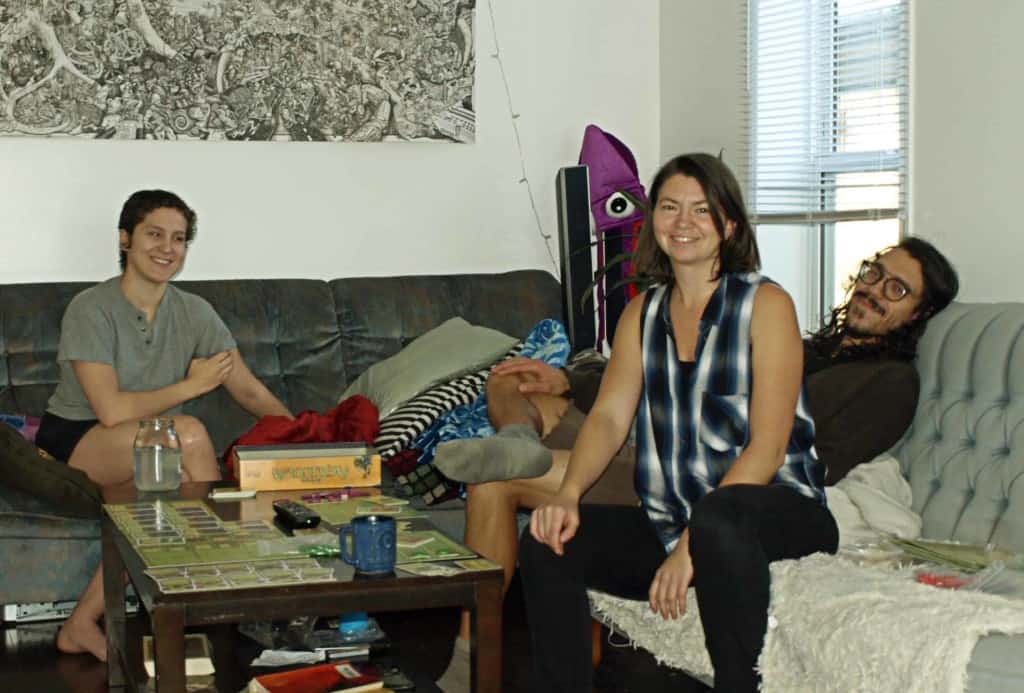Sharing homes and developing community
Communal living can turn strangers into friends
Living is an expensive endeavour, with rent or a mortgage eating up far more than the 30 per cent of our income we were always told to budget.
So what better way to save money than by sharing rent? Group living was always a dream of mine growing up. That was back in the day of free-love and hippiedom. We were exuding idealism and enthusiasm, but had very little insight into how to make the concept work.
I was thrilled to hear communal living or co-living seems to be alive and well in the three homes I visited.
House #1

My first interview began with a rather awkward introduction at the front step of a home in Parkdale. I explained I was there in response to an ad they posted for a roommate.
A confused pause.
“Oh, that. I should have taken that down before now. We are actually full at the moment.”
I explained I was there to interview them, and Courtney and Daniel promptly invited me to dinner. Now that’s the kind of welcome I can warm up to.
I joined them in the cozy living room. Daniel apologized for the hammer, assorted tools, and computer on the coffee table. “Heh, this is what communal living looks like. Everyone has their own idea of neat.”
The roommates are all under 30 years old, but have varied backgrounds and come from different provinces. If there’s a common denominator amongst them, it’s “to be open minded and enjoy being with others. It’s not just about renting a room,” said Daniel.
Courtney moved to Edmonton from Halifax, and she explained co-living was a good way to share expenses and “have a ready-made extension of family. I love the close interaction, sharing, warmth. It sure beats coming home to an empty space,” she said. “It always take some adjusting to new residents, getting to know people and establish relationships. The less turnover the better.”
The house is home to six people at the moment. With the $1,850 rent divided and the grocery bill shared, it’s definitely affordable. But many other factors must be taken into account, such as cleaning, cooking, and outdoor maintenance.
“We didn’t want a chore chart. We try to create a system that isn’t a system. We are not fans of rigidity, more about figuring things out as we go along, keeping it organic,” said Daniel.
Although they don’t have a formal system, they discuss concerns when necessary.
Upcoming household projects include developing an aquaponics growing system, a cricket farm for the fish, and perhaps chickens and bees.
“It may end up more a communal farm than a communal house,” said Daniel.
I reluctantly turn my back on the invitation to dinner as I pack up to leave for dinner at home. This was always my idea of group living: an open door policy, a warm meal, and a soft couch.
House #2

Eric meets me at the door of a home in Parkdale. He proudly tours me through the finished basement, which initially was just a mud hole. The house was purchased by Eric’s father at his and his brother’s request, gutted and then refitted for group living. Now there are six residents with two-and-a-half bathrooms and lots of space.
He explained there isn’t one common thread that drew the roommates together.
“Maybe just students just out of school wanting cheap rent. Most of us have an arts background, several are musicians. Otherwise, you just need to enjoy others’ company,” Eric said.
But the roommates don’t simply share the house; they work on developing friendships.
“We try to be intentional about spending time together,” Eric said.
That time might include simply visiting, engaging in intense discussions or playing board games.
“We have learned to be comfortable with each other and don’t tiptoe around each other. But if someone feels stepped on, they say so. This intimacy is really the rich part of this experience. Sometimes all six of us are in the living room doing completely different things but comfortable with the quiet. That is absolutely my favourite thing,” Eric explained.
While everyone makes an effort to interact with one another, there are different personalities, work schedules, and so on. But they’re an affectionate and respectful bunch.
“We value mental health and take care to be very affirming. This house is a safe zone. We allow expressing emotions. It is safe to cry and be vulnerable,” explained Eric.
I am impressed with the warmth and emotional depth Eric is describing. This house is breaking new ground.
House #3

Lenn, Hussein, and Tao joined me around the table for tea. Four of them rent and share two units in a fourplex in Eastwood.
All four of them settled into the community recently.
Explained Lenn: “We wanted to live in a way that was beneficial to the community as well as be supportive to each other.”
“We want there to be a difference between just renting and sharing lives. It is important to have a connection with roommates, to share common interests,” added Hussein.
The importance of being a boon to the community is reflected in their professional lives. Lenn connects neighbourhoods, while Hussein works with at-risk youth, and both are involved in community work for their church.
But Lenn emphasized there isn’t “a specific mandate with identified values. We want this to be more organic, to let it be known that our doors are open and welcoming. Have a house warming, invite the neighbours. Boardgame night. Friends over for tea.”
Like any household, everyone has a job.
“We have a chore list and a shopping list for groceries and we make an effort to eat together, but there is a lot of flexibility and fluidity,” said Lenn.
This house is newly formed and they all acknowledge that the community life is still mostly in the vision stage. I recognize threads of faith tradition pulling this together, although it is not expressed overtly.
There you have it. These three homes embrace communal living in three very different but equally positive ways. While co-living is not for everyone, these close-knit households have found ways to brighten one another’s lives beyond saving money on rent.
Featured Image: In the first home, roommates relax by playing a board game and watching a university lecture. | Aydan Dunnigan-Vickruck







